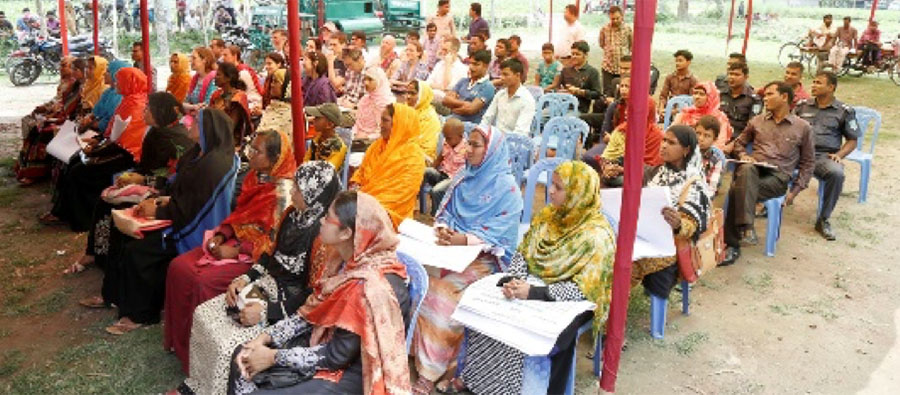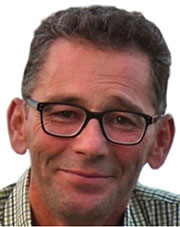In Bangladesh, nearly half the population works in farming and roughly 70% of the land is used for agriculture. Smallholder farmers are critical to food security, but crop yields and family incomes are staggeringly low – roughly 40% of the country’s population lives on less than $1.25 a day and 41% of children under five are chronically undernourished. But without access to training, technology and markets, smallholders struggle to meet the demands of the country`s fast-growing population.
Developing thriving rural communities is critical if we aim to double agricultural productivity of smallholders, a major aim of the United Nation’s Sustainable Development Goals to end hunger by 2030. It’s also one of the six targets of Syngenta`s Good Growth Plan. Our commitment is to reach 20 million smallholders by 2020 and enable them to increase agricultural productivity by 50%.
It’s in this context that we co-created a smallholder outreach program called Growing Together with Voluntary Services Organization (VSO), a leading international development NGO. The program brings together Syngenta`s global agriculture expertise with local know-how to help improve the livelihoods of smallholder farmers and support their communities. Our partnership with VSO is proving to be very successful with measurable benefits for rural communities and our volunteering employees.

In Bangladesh, nearly half the population works in farming. Photo courtesy of VSO & Syngenta.
The Growing Together program has already delivered impressive results. Since 2014, we`ve helped triple the net income of 10,000 smallholder farmers. We`ve done this by establishing 230 farmer groups where smallholder farmers and landless labourers meet monthly to discuss the social and agricultural issues, and input some of their profits into saving accounts, which to date have accrued over US$180,000. These farmer groups have also made progress on shared social issues in areas such as child marriage, water and sanitation and access to education.
An aspect of the program is the placement of Syngenta employees from across the world into the heart of poor rural Bangladeshi communities. They share modern agricultural techniques with smallholders and help them gain access to financial services such as savings accounts and loans as well as sell their crops in national and international markets. In return, volunteers gain valuable insights into the needs, challenges and aspirations of smallholder farming communities.
The project framework is based on the following three pillars:

Pillar one: Community development
The formation of community groups plays an important role for developing smallholder capabilities. Members share a common vision, meet regularly, own a group savings account for collective investments and resilience and have defined roles and responsibilities.
The most marginalized people in the groups are ultra-poor farmers, many of whom are women and do not own land. Specific grants for the ultra-poor are provided to support and include them alongside ongoing group activities. Each group has at least 30% female membership.
Community groups meet monthly to discuss the social and agronomic issues that are affecting them. This year groups have shared social issues in areas such as child marriage, water and sanitation and access to education. The groups discuss these challenges and work together to find solutions.
Achievements to date:
- 230 farmer groups and 45 youth groups have been formed
- Combined, the savings of all groups within the program now totals $181,250 USD
- 91% meeting attendance rate throughout the year
- 91% of participating women have higher confidence in modern farming practices
- 32% of participating women say they have increased decision making power and influence within their families.
Pillar two: Farmer training on good agriculture practice
At the beginning of the program, only 7% of farmers in the target communities had access to agricultural advice services. So we developed a training framework that includes ‘learning from peers’ approach achieved through demonstration plots in which nominated lead farmers share new farming techniques learned from agronomic experts.
Demonstration plots allowed farmers to test new techniques in a risk free environment and directly compare progress with their own fields.
Achievements to date:
- 230 demonstration plots had been set up by January 2017
- 7,000 farmers (2,240 female) have received agronomy training in rice, vegetable and potato cultivation since the start of the project
• 96% of farmers report that they are now proactively practicing the new farming techniques, including correct and safe use of agro-inputs - Farmers from the Mithapukur region now cropping a mix of rice, potato and vegetable recorded an average increase in net income of 50% from 2015 (average US$912 in 2016 versus US$613 in 2015) and a tripling of net income since 2014
Pillar three: Value chain development and Farmer Centers
The third pillar of the project is to ensure that market systems are conducive to smallholders earning a sustainable income from their crops. Six Farmer Centers have now been established providing a physical space for farmer groups to aggregate their crops. The centers provide access to a broad range of services including rental of machinery, access to inputs (such as seeds) and finance, trading support and access to affordable storage so that farmers can sell their crops when the price is best.
The Farmer Centers also offer support and training on how best to engage with agricultural supply chains and negotiate mutually favorable terms.
Achievements to date:
- 100% of participating farmers are now using services provided by the Farmer Centers
- 65% of project farmers are engaged in national and international contract farming through the Farmer Centre aggregation service
- In 2016 Growing Together rice farmers in Birampur district increased net incomes by an average close to 20%, while potato farmers in Mithapukur more than doubled their average net incomes.
Growing Together has proved to be a successful development model and the program now aims to scale the approach to reach over 100,000 smallholder farmers by mid-2018. More information about the program can be found at: http://story.vsointernational.org/Growing-Together/
Visit www.farmingfirst.org/SDGs for quizzes, videos, infographics & more on SDG 2.3. Share your stories on doubling productivity & incomes using #Ag4SDGs and join the campaign!



